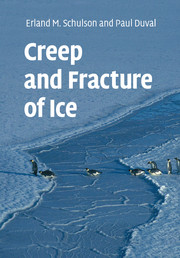Book contents
- Frontmatter
- Contents
- Preface
- Acknowledgements
- 1 Introduction
- 2 Structure of ice
- 3 Microstructure of natural ice features
- 4 Physical properties: elasticity, friction and diffusivity
- 5 Plastic deformation of the ice single crystal
- 6 Ductile behavior of polycrystalline ice: experimental data and physical processes
- 7 Modeling the ductile behavior of isotropic and anisotropic polycrystalline ice
- 8 Rheology of high-pressure and planetary ices
- 9 Fracture toughness of ice
- 10 Brittle failure of ice under tension
- 11 Brittle compressive failure of unconfined ice
- 12 Brittle compressive failure of confined ice
- 13 Ductile-to-brittle transition under compression
- 14 Indentation fracture and ice forces on structures
- 15 Fracture of the ice cover on the Arctic Ocean
- Index
- References
4 - Physical properties: elasticity, friction and diffusivity
Published online by Cambridge University Press: 01 February 2010
- Frontmatter
- Contents
- Preface
- Acknowledgements
- 1 Introduction
- 2 Structure of ice
- 3 Microstructure of natural ice features
- 4 Physical properties: elasticity, friction and diffusivity
- 5 Plastic deformation of the ice single crystal
- 6 Ductile behavior of polycrystalline ice: experimental data and physical processes
- 7 Modeling the ductile behavior of isotropic and anisotropic polycrystalline ice
- 8 Rheology of high-pressure and planetary ices
- 9 Fracture toughness of ice
- 10 Brittle failure of ice under tension
- 11 Brittle compressive failure of unconfined ice
- 12 Brittle compressive failure of confined ice
- 13 Ductile-to-brittle transition under compression
- 14 Indentation fracture and ice forces on structures
- 15 Fracture of the ice cover on the Arctic Ocean
- Index
- References
Summary
Introduction
In this chapter we review the elastic behavior of ice, friction of ice on ice and mass diffusion. In terms of creep, elastic properties allow the applied stress to be normalized and thus the behavior to be analyzed within the context of physical mechanisms (Chapters 5–8). The mass diffusion coefficient plays a similar role in creep under low stresses. It is important, as well, to the transformation from snow to ice (Chapter 3). In terms of fracture, elastic constants affect fracture toughness (Chapter 9) and, through that property, both the tensile (Chapter 10) and the compressive strength (Chapters 11, 12). Elasticity is also relevant to the ductile-to-brittle transition (Chapters 13) and to ice loads on structures (Chapter 14). Friction is a factor in the DB transition under compression and is a major consideration in brittle compressive failure, on scales small (Chapters 11, 12) and large (Chapter 15). Friction is also fundamental to tidally driven, strike-slip-like tectonic activity on a number of icy satellites within the outer Solar System, including Jupiter's moon Europa (Greenberg et al., 1998; Hoppa et al., 1999; Schulson, 2002; Kattenhorn, 2004), Neptune's Triton (Prockter et al., 2005) and Saturn's Enceladus (Nimmo et al., 2007; Smith-Konter and Pappalardo, 2008). Thermal properties play a less direct role, but we list them for completeness, Table 4.1.
Elastic properties of ice Ih single crystals
Elastic properties have been relatively well studied.
- Type
- Chapter
- Information
- Creep and Fracture of Ice , pp. 51 - 76Publisher: Cambridge University PressPrint publication year: 2009



